6th March 2013
A Quick Peep Around Stonetown, With a Visit to the Old Fort and Inside a Sultanate's Palace
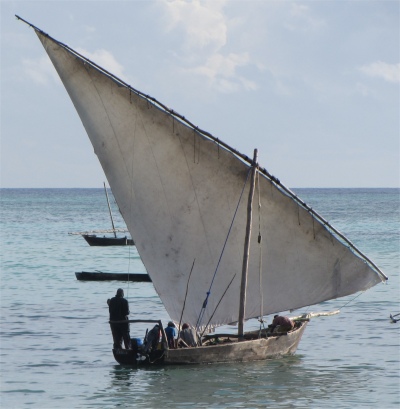
Returning Dhow
|
A glorious morning greeted us to yet another transit day. Golden splashes between slanting long shadows graced the lawn outside the hotel, and the turquoise sea beckoned. I would miss this town of pearly dawns and fiery sunsets.
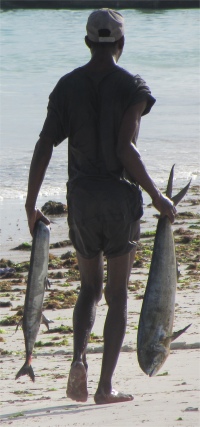
Morning Catch
|
I strolled across to the beach and walked up the virgin white sands towards the northern tip. Many of the dhows that set out fishing the previous evening had returned; a few stragglers were still creeping over the horizon. A couple of the vessels had only just pulled up close to shore, and I watched a young fellow carry a couple of long fish up the beach. Following his footsteps up to higher ground, I came across a group of men sitting under a shelter, and a selection of the night's catch was spread out on the sand. The sun had long dulled the once bright eyes of these delicately coloured nomads of the sea, some as long as 1.5m. It was sad to see them drying out, the sandy floor gradually getting baked on to them; a total contrast to back home where the illusion of freshness is maintained in fishmongers by resting the catch on beds of ice.
After breakfast, we used Sally's book on East Africa to earmark a place to stay in Stone Town; we would just turn up on the off chance. Internet connectivity was not possible; the power had still not returned since last night's power cut!
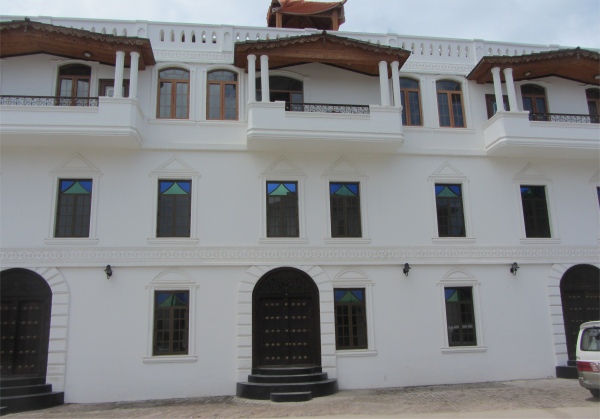
Smart Stone Town Building - Notice the Ornate Doors
|
A shared-taxi man picked us up promptly at 09:30, and we then did a tour of Nungwi, picking up others until the vehicle was brimming with bodies and luggage. Then we were launched down the road to Stone Town.
We passed through lush land, not surprising considering the amount of rain we had been getting, and occasionally passed villages and schools where the children smiled and waved cheerily. The driver was on a mission. Any cyclist or motorbike approaching from the opposite direction were forced onto grass, dirt or ditch as he overtook yet another vehicle.
The monotony of the journey was broken by a heavy downpour, which seemed to spur on our driver even faster, but that was soon replaced by dazzling sunshine.
As we entered the outskirts of Stone Town, the driver's sidekick, or was he the man who yanked the handbrake during the handbrake turns, turned round and asked us all where we were heading to in Stone Town. These chaps delivered door to door. We gave him the name of the place we were heading to, which was close to the centre of town. We were first to be dropped off it seemed. A drive down tight, busy backstreets brought us into what seemed like a medieval industrial area, not at all a savoury environment, noisy, smelly, dirty and not the place to be. Our driver stopped and his sidekick asked us to alight. I thought he was going to help us retrieve our kit from the bottom of the pile, but he told us to leave it until we had checked in.
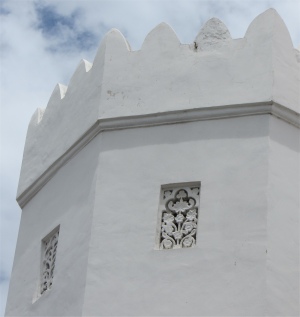
Castellated Tower
|
"Follow me," he said, and he led us through a deluge of filthy trucks, all vying for space in the narrow roadway which was already heaving with filthy looking handcarts. Old skeletons of men with tearing coughs and running eyes weaved through the mayhem, heaving heavy loads from vehicles to warehouses. The squalor was appalling, the stench a mixture of rotten fish and raw sewage. Turning off into an alleyway only wide enough for one person to pass through, we caught sight of a slum at the end; our earmarked accommodation. We looked at each other thinking this was Hades. Our guide sensed and probably had anticipated our reaction, which is why he insisted we leave our kit in the cab. "Have you anywhere else in mind?" he asked. Sally immediately thought of Flamingos, a hostel slightly further out of the town centre, where she had stayed before. Soon we had been dropped off near Flamingos, and as luck would have it we got the last two rooms available. It was a pretty basic but clean establishment: a bed, wash basin and shared toilet/shower. But, hey, that's all I need, and at $15 per night, which included breakfast on the roof, you can't complain.
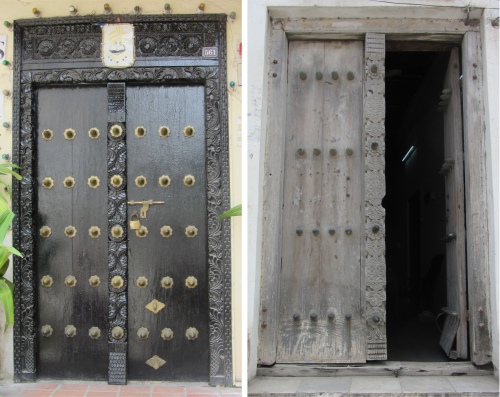
Stone Town Doors
|
Stone Town is the heart of old Zanzibar. It is essentially a 19th century centre, though sadly many of its buildings have been allowed to crumble. Its higgledy-piggledy jumble of dusty streets show Arabic and Indian influences, and some 500 of them still preserve the huge, ornately carved wooden front doors that are the most famous feature of Zanzibari architecture. Arabic-style houses with their recessed inner courtyards rub shoulders with Indian-influenced buildings boasting ornate balconies and latticework, and bustling oriental bazaars alternate with street-side vending stalls.
Once ensconced, Sally took us a long way round through back streets and arterial roads towards the sea. On the way we came across colonial looking, majestic buildings. Some of these served as official, administrative or government buildings where guards snarled if they caught sight of a camera pointing in their direction. In between sat all manner of residential multi-storey buildings in various stages of maintenance. Ground floors were often small shops or businesses, restaurants, but no bars.
There were no dirt verges here, roads butted straight up properties, while on arterial roads pavements could be found. Litter was orders of magnitude less than that encountered in Nungwi.
Sally led us off down a sunny side street, side stepped into a building with a cavernous room possessing white-washed walls, a large square bar in the centre, and good music from two large free-standing loud speakers echoing throughout the cathedral like enclosure. We stepped out of one side of this room into a sunny sandy enclosure with tables and chairs overlooking the beach. This was Livingstone's. Here we relaxed watching the activity on the beach and water, and enjoyed a light salad and refreshing drink.
|
|
Sea View from Livingstone's (please use scroll bar)
|

Beach Ferry. Only those Vehicles that Can Negotiate the Soft Sand Can Use the Ferry .... Crazy!
|
Nearby stood a small clump of coconut trees, where we watched a man scale one of them in his bare feet, and from a lofty height he threw down some of the nuts. He then rested for a while atop the tree and drank and ate the contents of one of the fruit.
This idyllic setting was shattered when a ship started continuously sounding its horn as it slowly edged towards the shore. Small craft anchored in front of Livingstone's started to clear away further along the beach. It became apparent that the ship was a ferry, honking advice that it was going to pull in right by the bar. It slowly beached its bow and lowered a ramp onto the sand. A vehicle on board the ferry revved its engines and then at high speed shot down the ramp and up the sandy incline, managing to make the sealed road. A car on the road then launched itself down the beach and with sand spraying from its spinning wheels, managed to hurl itself onto the ramp, only just making it. This was entertainment, and people gathered to watch. Then a small 4x4 came down the road towing a rusty bus that had seen better days. As soon as the buss's front wheels got onto the sand, the combination ground to a halt. After much shouting and gesticulating, the 4x4 was despatched to the rear of the bus where it slowly towed the bus back off the sand and onto the road. The next thing, a gang of guys were pushing the bus towards the ship, but again, as soon as the buss's wheels got onto the sand progress was halted. Eventually the bus was towed away from the scene never to be seen again.
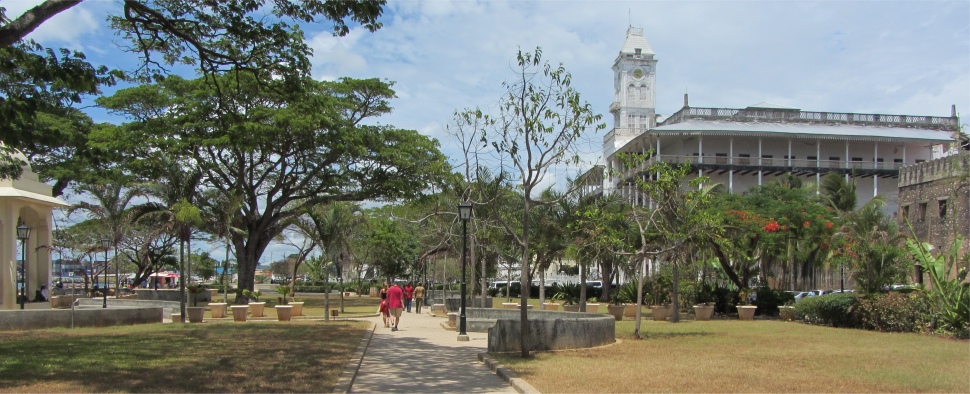
Forodhani Gardens, with Beit el-Ajaib (House of Wonders) Behind and the Old Fort Sneaking in on the Far Right
|
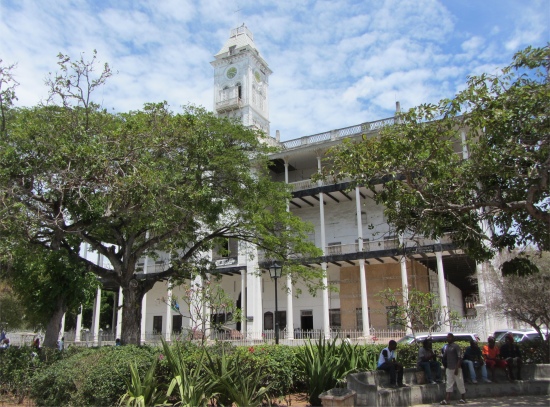
Beit el-Ajaib (House of Wonders)
|
We walked through the pleasant Forodhani Gardens, with the Old Fort to our right. Next to it stood the Beit el-Ajaib, now the National Museum. By now the sun fiercely beat down upon us, unbearably so. We stopped for a drink, more to escape the vicious rays than to take on board liquids. Dan was keen to sort out his ferry ticket to Dar es Salaam as soon as possible, so, leaving Sally sheltering in the shade, Dan and I headed up to the ferry terminal. We passed the Beit el-Sahel or Sultan's Palace, the ornate Zanzibar Conservation Centre, and the Old Dispensary before entering the severely congested area around the ferry terminal.
Here folk were being picked up or dropped off, with the knock-on effect that the narrow road was being blocked to cars, cabs, busses, handcarts and trucks. Horns were honking and tempers were fraying. Cyclists and motorbikes always managed to squeeze through such mayhem. This is how I imagine Calcutta to be.
We eventually reached a major roundabout that linked the ferry terminal to major arterial roads. This was gridlocked with a circular convoy of trucks stuck around it and on the feeder roads. The whole scene was bedlam, with nothing able to either enter or leave the terminal. So, 19th century planning still rules in these parts.
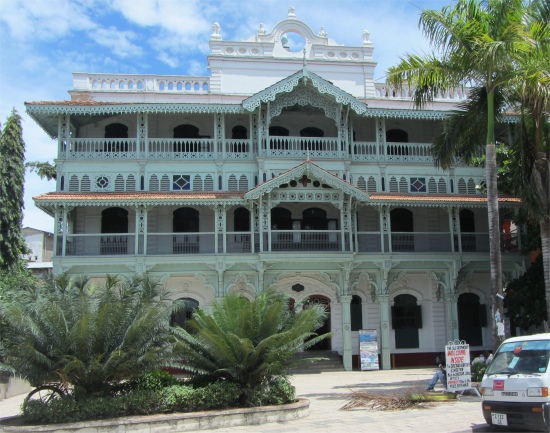
Old Dispensary
|
Sticking our noses into the road heading into the terminal, we were pounced upon by a harassment of touts, all trying to sell ferry tickets of dubious validity. In the mayhem, we could not locate the official ticket office. After being given a few run-arounds, we gave up and returned to Sally, who had been waiting patiently in the shade. Upon learning of our miserable failure, she took us back to the terminal and showed Dan the official ticket outlet. Sally reckoned he'd need his passport with him, and of course he didn't, so he'd have to return with it later. The heat now was beyond belief, and it was starting to make Sally feel a little ill, not surprisingly. We immediately grabbed a cab and got her back to the hostel so that she could shower and lay down.
With Sally safe, Dan and I headed towards the market and bus station area, where I was lead to believe ATMs existed on the way. We did find plenty, but none would accept non-Tanzanian cards. But the hike gave us the opportunity for an early explore of the Darajani Market which sat alongside Creek Road, a main highway effectively bypassing the old quarter. Here a thriving, bustling, colourful, noisy clamour assaulted the senses, with occasional whiffs of spices mixing with the stench of fish, the clamour of vendors hawking their wares, neat, brightly coloured piles of fruits and vegetables, and dozens of small shops selling everything from plastic tubs to auto spares. The aroma in the fish hall nearly knocked Dan off his feet, and he almost declined to enter the claustrophobic space. The adjacent meat hall had almost sold out by this time of day. Outside lay a village of stalls selling a colossal variety of colourful, fragrant fruit and vegetables, the heady aroma mixed with that emanating from the multitude of spice stalls. Dan was keen to take some spices back home, and set about informing himself of what was on offer and for what price.
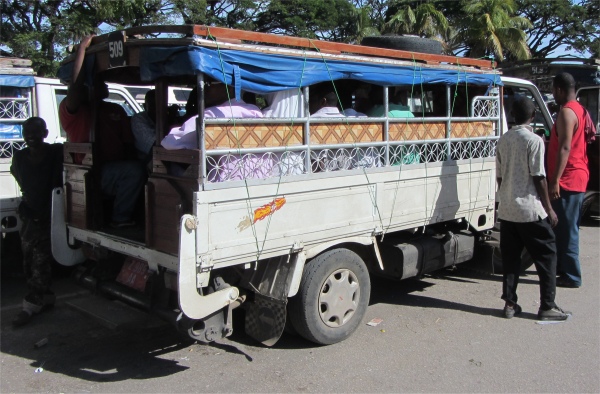
Dala-Dala
|
On extracting ourselves back onto Creek Road, we separated off into different directions, Dan to the ferry terminal, and me to the only branch of Barclays in this end of town, Barclays being the only bank that would accept my cards. We made a simple meet up arrangement - the cafe by the sea where Sally had waited for us.
I walked through the busy bus station on my way to the bank, where literally hundreds of minibuses and dala-dalas parked up, disgorged hoards of people, took on board fresh hoards laden with bags and packages, and then slowly honked their way through the masses to get back to the road. Small stalls selling food, mobile phone covers, SIM cards, household cleaning goods and others selling what I'd call junk, lined the side of the main road. With the sheer numbers of folk hustling and bustling by the stalls, spilling out onto the main road, I could see why the East Africans have no hang-ups about personal space. Sally had often told me that when she is travelling in the dala-dalas in Kenya, it is not uncommon to have legs and arms over each other, or to see babies passed person to person to the back of the bus.
I managed to withdraw some cash at the Barclay's ATM, and then took a heroic plunge into the heart of the maze of dark, narrow passageways that sat between the market and the seafront, in order to meet up with Dan. I'd forgot to bring my compass, so I took a note of where the sun was in the sky, and used that as my navigational aid, when I could see it in the narrow alleyways of course. I succeeded in popping out at the other end only 50m from where he was sitting. We sat together in the shade, and enjoyed another Tangawizi before heading across the road to investigate the Old Fort.

Old Fort from Forodhani Gardens
|
The Old Fort was constructed on the site of a Portuguese church which had been built between 1598 and 1612. It was built between 1698 and 1701, immediately after the two-century Portuguese occupation of Zanzibar, by the Busaidi group of Omani Arabs who took control of Zanzibar in 1698, and was originally used as a defence against the Portuguese and a rival Omani group, the Mazrui, who occupied Mombasa at that time. In 1832, after Sultan Said's move to Zanzibar, the fort became a prison and criminals were incarcerated, punished and sometimes executed. Then, in the early 20th century, the fort became a depot for the railway which ran from Zanzibar Town to Bububu, north of Stone Town. In 1946, the fort was refurbished by the British and used as a club for women of all communities, the main courtyard was used as a ladies' tennis club, but after the 1964 Revolution it fell into disuse.
Today, the fort has been renovated and is open to visitors. The faded golden-brown, squat edifice comprised four coral ragstone walls, with cylindrical towers at the corners and a fifth in the centre of the south wall. In the main courtyard remnants of the old church could still be seen built into the inside wall. In 1994, a section was converted into an open-air theatre for performances of contemporary and traditional music, drama and dance. And of course, it would not be complete without its collection of kiosks and stalls selling gifts and souvenirs.
|
|
Old Fort Courtyard (please use scroll bar)
|
We needed more shade. Next door stood the Beit el-Ajaib, also known as the House of Wonders, which was built around 1883 as the ceremonial palace for the ruling sultan, Sultan Barghash. After British naval bombardment in 1896 it was rebuilt and used as a residential palace for the Sultans and later the headquarters of the CCM (Tanzania's ruling party). This is one of the most prominent and magnificent structures in Zanzibar and all of East Africa, and was the first building in East Africa to have electricity and an electric elevator. Beit al Ajaib can be seen from a great distance while approaching Zanzibar from the sea, and now acts as a symbol of Zanzibar's rich history and is featured on many postcards and history books. Today it is home to the Zanzibar National Museum of History & Culture. Having said that, it was closed throughout our stay in Stone Town - a pity.
However, all was not lost, and we headed slightly further past it to the Beit el-Sahel or Sultan's Palace. The palace was a large building with castellated battlements overlooking the Indian Ocean on Mizingani Road in Stone Town. Originally called the Sultan's Palace, it was built in the late 1890s, this imposing white-washed building was erected for members of the sultan's family and is the most recent of the Sultan's palaces in Zanzibar. This palace served as the sultan's residence until 1964 when the dynasty was overthrown. Now it's a museum devoted to the era of the Zanzibar sultanate. Our guide, an old wizened chap, had a decent command of English, and gave us a hasty but informative tour of the palace. Sadly, I was not allowed to take photos inside the palace. We climbed the central staircase and peeled off into rooms archiving the sultanate era (1828-1964) with an eclectic mix of leftover furniture, paintings and such like. Each floor represented a different period.
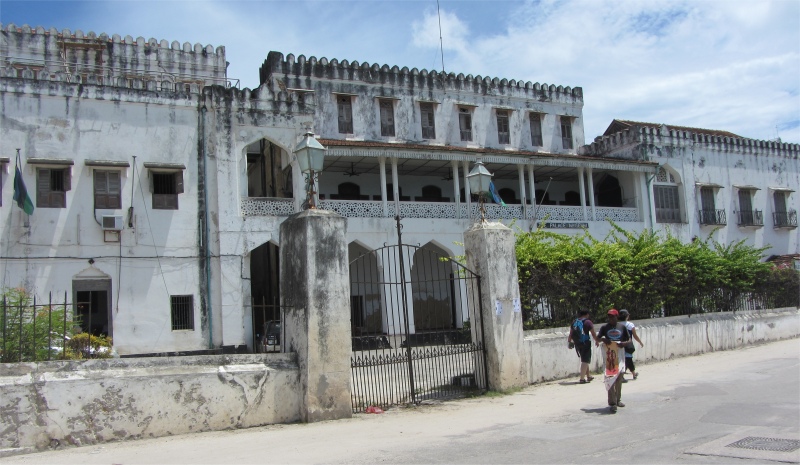
Beit el-Sahel (Sultan's Palace)
|
The ground floor displayed details of the formative period of the sultanate from 1828 to 1870, during which commercial treaties were signed between Zanzibar and the USA (1833), Britain (1839), France (1844) and the Hanseatic Republics (1859). Of particular note was a room dedicated to the famous Princess Salme, daughter of Sultan Said, who fell in love with the German merchant Rudolph Heinrich Ruete. The couple eloped to Hamburg in 1866, which meant that Salme had to say farewell to Zanzibar. Renowned for her manuscript "Memoirs of an Arabian Princess from Zanzibar", her autobiography is the only known written account of what life was like for Arab women of the Royal court in the 1800s, and provided a fascinating glimpse into regal Stone Town life. The exhibits on the 2nd floor focused on the period of affluence from 1870 to 1896, during which modern amenities such as piped water and electricity were introduced to Zanzibar under Sultan Barghash. The 3rd floor consisted of the modest living quarters of the last sultan, Khalifa bin Haroub (r 1911-60), and his two wives, each of whom clearly had very different tastes in furniture.
In 1911 the palace became the official residence of the Sultan of Zanzibar. After the 1964 Revolution, when Sultan Jamshid was overthrown, it was renamed the Peoples' Palace and used as government offices. In 1994 it became a museum dedicated to the history and lifestyle of the Sultans of Zanzibar.
Incredibly, a significant collection of the Sultan's furniture and other possessions survived the revolution and can be seen. Some of the contents on display include thrones, paintings, family photographs, banqueting tables, ceremonial furniture, pieces of Princess Salme's personal wardrobe and even the sultan's personal water-closet.
In the palace garden was Makusurani graveyard containing the graves of Sultans Said, Barghash, Majid, Khaled, Khalifa and Abdullah.
Totally cultured out now, we headed into town to undertake present shopping. Meanwhile Sally had recovered from the effects of the heat, and had made her way to meet us. It was now dark, and we headed back to the Forodhani Gardens, which were alive with lights and food stalls. Forodhani means "unloading place", and in past times many unfortunate slaves were discharged here from dhows. Locals and tourists alike had flocked down to the gardens on the waterfront, where a nightly food market served up hot griddles laden with seafood. Thirst was quenched by some with a freshly squeezed sugarcane juice, vendors urged us to sample skewers of octopus dipped in tamarind, lobster and crab claw, platters of prawns and Zanzibari pizza (a chapatti-type pita bread stuffed with mincemeat, egg, mayo, onion & chilli). It was all a world away from the sedate scene presented during the daytime.
However, we were not tempted, and instead headed to a first rate Indian restaurant that Sally knew. Suitably fed and watered, we ambled back to our hostel for a welcome sleep.
|
Last updated 9.4.2013
|














